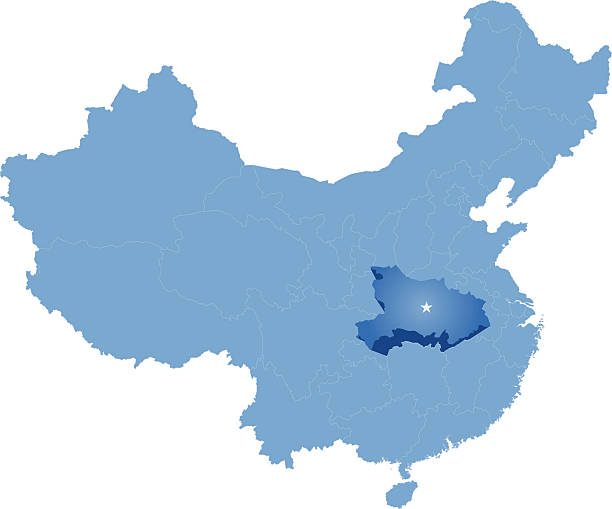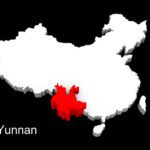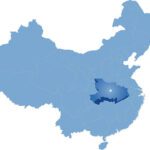The Center for the Scientific Study of Families reports are designed to provide relevant information about the conditional state of families in a specified context. The report provides information such as population, culture, family structure, and family life.
Family reports are an important tool for improving the lives of families. By providing information about the family’s conditional state and context, family reports can help improve communication between families and service providers and lead to better outcomes for families and children
Overview of Hubei
Hubei Province (pronounced “Who-bay”), located in central China, is an area steeped in rich historical and cultural significance. It is strategically situated in the Yangtze River basin, featuring a diverse topography that includes both mountainous regions and fertile plains. This geographical diversity has shaped the lifestyle and economic activities of its inhabitants. Hubei has been a center of civilization for thousands of years, and its history is deeply intertwined with the broader narrative of Chinese culture, from ancient kingdoms to its role in modern China’s development.
Number of Families and Households & Composition
According to the National Bureau of Statistics of China, in 2022, Hubei Province had a relatively smaller number of households compared to the national total in China, with about 20,180 households in Hubei against over 51 million nationwide. The population of Hubei stood at approximately 59.96 million, a fraction of China’s total population of about 1.44 billion. The sex ratio in Hubei, which shows the number of males per 100 females, was slightly higher at 106.18 compared to the national ratio of 104.43, indicating a marginally greater male prevalence in Hubei. Additionally, in Hubei, as in much of China, family size and composition have been influenced by historical policies such as the one-child policy and, more recently, by the relaxation of this policy. Traditional family structures, characterized by multiple generations living under one roof, are giving way to smaller family units. This shift is more pronounced in urban areas, where space constraints and lifestyle changes contribute to the preference for nuclear families. The average family household size in Hubei was also slightly higher, with an average of 2.90 persons per household compared to the national average of 2.76 persons. This suggests that households in Hubei are typically larger than the national average.
Ethnic and Racial Diversity

Hubei, China – 02.09.2024: Women dressed in red go door to door singing and performing the Yangko boat dance for donations during the Chinese Spring Festival
Han people make up the majority of Hubei’s population. Hubei Province exhibits a diverse ethnic composition, reflecting a broader pattern of ethnic distribution in China. According to the National Bureau of Statistics of China, 2022, the ethnic minorities, the Miao and Tujia communities, are notably present in Hubei, contributing to the province’s rich cultural tapestry.
Miao Ethnic Group in Hubei:
The Miao people, known for their unique languages, vibrant textiles, and rich cultural heritage, are one of the significant ethnic minorities in Hubei. They are part of a larger Miao population spread across several provinces, including Guizhou and Yunnan, but their presence in Hubei is specifically notable in certain regions.
Tujia Ethnic Group in Hubei:
The Tujia, another prominent ethnic group in Hubei, are well known for their distinct cultural practices and traditional beliefs. The Tujia people have a strong presence in several central provinces of China, including Hunan and Chongqing, with a significant number also residing in Hubei.
These communities, along with others, contribute to the ethnic and cultural diversity within Hubei, playing a crucial role in the social and cultural dynamics of the region. The province’s policies and programs often aim to promote and preserve the unique cultures and languages of these groups, ensuring that they remain a vibrant part of Hubei’s identity. Administrative support for ethnic minorities in Hubei is part of a broader national policy aimed at enhancing the development of minority regions and integrating diverse cultural heritage into the mainstream development agenda.
Household Consumption Expenditure
The National Bureau of Statistics of China looks into the evolving economic landscape of Hubei Province through the lens of household consumption expenditure from 1978 to 2022. Over these decades, there has been a remarkable increase in the spending capacity of both urban and rural households. Urban households, for instance, have seen their expenditure rise from 393 yuan in 1978 to 36,289 yuan in 2022, while rural households have also experienced significant growth, from 139 yuan to 19,530 yuan over the same period.
This growth in household expenditure is indicative of China’s broader economic development, reflecting the substantial uplift in living standards across Hubei. The data also highlights the narrowing gap between urban and rural consumption, which decreased from a ratio of 2.8 in 1978 to 2.0 in 2022. This suggests a successful effort to bridge the economic disparities between urban and rural areas, likely a result of targeted government policies aimed at rural development. These policies may include investments in infrastructure, agricultural technology, and educational initiatives, which have collectively contributed to raising rural incomes and integrating rural economies with urban centers more effectively.
The influence of urbanization on reducing the urban-rural income disparity in Hubei is highlighted in a study which discusses the phases of urbanization and their effects on rural areas. The research indicates that as urban areas grow, the initially polarizing effect on rural incomes shifts to a diffusion effect, thus narrowing the income gap during the middle stages of urbanization. Additionally, the adoption of digital inclusive finance has also been instrumental in reducing income inequality between urban and rural areas. By expanding access to financial services and resources, digital finance has directly supported rural economic activities, leading to increased incomes.
The trends observed in Hubei are a microcosm of China’s shift towards a more consumption-driven economy, with an emphasis on balanced regional growth and enhanced living standards. As Hubei continues to develop, its economic progress is expected to mirror national economic strategies that prioritize sustainable development and equitable economic opportunities across all regions.
Employment and Unemployment Rates
Based on the employment data for Hubei as of the end of 2022, the region had a total employed population of 3,243,000 individuals, with a significant portion (1,897,000) employed in urban areas and a smaller segment in rural areas (1,346,000). The employment distribution across industries shows a concentration in the tertiary (service) sector with 1,469,000 people employed, followed by the secondary (manufacturing) sector with 846,000 employees, and the primary (agriculture) sector employing 928,000 individuals.
Hubei’s unemployment statistics for 2022 indicate an urban unemployment rate of 3.4%. This reflects a general stability in employment despite the global economic fluctuations over the years. Factors influencing these trends include a combination of demographic changes, industrial evolution, and targeted governmental policies aimed at employment stabilization and growth.
The aging population in China has led to a gradual increase in the average age of the workforce, influencing labor market dynamics and potentially increasing dependency ratios. However, initiatives such as the “14th Five-Year Plan” focus on creating over 55 million new urban jobs by 2025, reflecting the government’s commitment to maintaining employment stability through policy support and investment in skill enhancement to adapt to the needs of a modernizing economy.
Furthermore, the government’s efforts to address unemployment through educational and training initiatives aim to align the workforce with the evolving industrial landscape, particularly as the economy moves up the value chain. Programs that enhance vocational skills and promote job creation in new economic sectors are central to this strategy (for more information, see: China Briefing,​ China Daily, and​ MDPI)​.
Education Levels
The educational landscape in Hubei Province reflects significant progress and challenges. In 2022, Hubei’s educational attainment levels witnessed growth, with a noticeable increase in residents pursuing higher education compared to previous decades. The average years of schooling for people aged 15 and above in Hubei reached 10.02 years, which is a marked improvement from previous years, highlighting ongoing educational advancement in the region.
However, Hubei also faces challenges with illiteracy, particularly among the older population, which still affects a considerable number of residents, with a higher illiteracy rate among females compared to males. This disparity is often attributed to historical educational policies and cultural factors that prioritized male education over female education, especially in rural areas.
These dynamics are crucial in understanding the socio-economic development in Hubei, where increased educational opportunities are needed to bridge the gap in literacy and educational attainment across gender and urban-rural divides.
For detailed statistics on educational attainment and literacy rates in China, including Hubei, you can refer to the national census data provided by China’s National Bureau of Statistics​ (National Bureau of Statistics of China)​.
Marriage and Divorce Rates
The 2022 marital status data from the National Bureau of Statistics of China for Hubei Province highlights several demographic trends within the region. There is a notable difference in the numbers of never-married males (2,284,734) compared to females (913,967), likely reflecting the historical effects of the one-child policy, which created a gender imbalance. This discrepancy makes it more challenging for many men to find marital partners. On the other hand, the number of married individuals is almost evenly split between males (30,875,363) and females (30,763,219), indicating that marriage is still a central and revered institution in Hubei. This suggests a well-integrated society that holds traditional values around marriage.
Furthermore, there are more divorced males (1,130,781) than females (503,812) in Hubei, which could be attributed to factors such as greater financial independence among men and possibly more favorable societal attitudes towards divorced men remarrying. The data also shows more widowed females (618,563) than males (290,815), aligning with global patterns where women typically outlive men. Age disparities in marriage, where husbands are typically older, frequently make this trend worse and cause earlier widowhood for women. These figures reflect how Hubei’s specific social and economic contexts influence demographic trends, particularly regarding marital status.
Most Pressing Challenges Facing Families in Hubei Province
Hubei Province, located in central China, is known for its diverse geography, rich history, and vibrant culture. However, families in the province face several challenges, ranging from economic hardships to social issues. This report highlights some of the most pressing challenges facing families in Hubei and the state programs available to help families navigate those challenges.
Aging Population
The demographic trend towards an aging population is particularly pronounced in Hubei. The percentage of the population aged 60 and above has been increasing, putting pressure on both family structures traditionally responsible for elderly care and on public healthcare systems. The shift requires adaptations in social services and healthcare to cater to an older demographic, which includes increased spending on elderly care facilities and services (China Yearbooks)​.
Population Breakdown and Aging Analysis:
- Total Population: 59,860 individuals
- Elderly Population (Aged 65 and Over): 9,753 individuals
- Elderly Dependency Ratio: 23.85%
The elderly dependency ratio of nearly 24% is a critical indicator of the demographic shift occurring in Hubei. This ratio implies that for every 100 working-age people (aged 15-64), there are about 24 elderly dependents. This is significantly high and underscores the pressure on the working-age population to support an aging cohort through social services, healthcare, and pensions.
Economically, an aging population could mean a shrinking workforce, affecting productivity and economic growth. Hubei might need to consider policies that encourage longer working lives or automation to sustain economic activities.
Environmental Concerns
Hubei Province has made significant strides in improving environmental protection, but challenges remain. Air pollution, water contamination, and soil degradation continue to pose risks to public health and can have negative impacts on families, particularly those in disadvantaged communities.
State Programs Available to Hubei Families
Hubei Poverty Alleviation Program
The Hubei Poverty Alleviation Program aims to reduce poverty in the province by providing targeted assistance to low-income families. The program includes measures such as job training, microfinance loans, and infrastructure development in poor areas. For a deeper understanding of the broader context of poverty alleviation in China’s Hubei Province, see the case study provided by the Journal of Rural Studies, which details poverty alleviation and its practices in rural China.
Hubei Elderly Care Program
The Hubei Elderly Care Program is specifically designed to address the challenges of an aging population in Hubei Province. This initiative supports the development of a comprehensive elderly care system through the construction of facilities and the provision of services tailored to the needs of the elderly. The program emphasizes the improvement of home-based, community-based, and residential-based elderly care services. Additionally, it includes training programs for caregivers and healthcare professionals to enhance the quality and availability of elderly care services throughout the province.
One significant project under this program is the Hubei Yichang Comprehensive Elderly Care Demonstration Project. This project is part of a broader effort to improve elderly care services in Yichang, a city within Hubei. It aims to establish a three-tiered elderly care system that integrates home-based, community-based, and residential care services. The project is supported by a partnership between the local government and the Asian Development Bank, which helps finance the development and expansion of these services​ (Asian Development Bank)​​ (Asian Development Bank)​​ (Cities Development Initiative For Asia)​.
Hubei Environmental Protection Plan
The Hubei Environmental Protection Plan is a comprehensive strategy aimed at addressing environmental challenges within the province. This plan includes targeted actions to mitigate air and water pollution, promote sustainable land use practices, and foster greater public awareness about environmental issues. Measures such as reducing emissions from industrial sources, enhancing the treatment and management of industrial and residential waste, and implementing stricter controls on land use to preserve natural habitats are integral to this strategy. The plan also focuses on improving the overall quality of water bodies by limiting pollutants and enforcing regulations around waste disposal.
These initiatives aim to protect the natural environment and make sure that environmental risks don’t endanger public health. The success of such initiatives often relies on the collaboration between government entities, local communities, and private sector to effectively implement and sustain environmental protection measures.
For further information on environmental protection strategies and measures similar to those in Hubei, you can refer to resources such as the European Commission’s Zero Pollution Action Plan, which outlines comprehensive targets and actions for reducing pollution across various sectors by 2050​ (Environment)​.
Conclusion
Hubei Province, with its rich historical tapestry and strategic geographical placement in central China, demonstrates a vibrant synthesis of ancient culture and modern development. The region’s demographic and economic profiles underscore both progress and ongoing challenges. Both historical policies like the one-child policy and recent socioeconomic changes have had a significant impact on family structure in Hubei Province. The prevalence of smaller, nuclear family units, particularly in urban areas, reflects these transitions. Despite a smaller number of households compared to the national average, the region’s families tend to be larger than those in other parts of China.Â
The ethnic diversity of Hubei enriches its cultural landscape, with significant populations of Miao and Tujia contributing to the province’s cultural depth. State programs aimed at alleviating poverty, supporting elderly care, and enhancing environmental protections illustrate proactive governance. However, the pressures of an aging demographic, environmental concerns, and the need for sustainable economic policies remain critical areas for ongoing focus.Â





